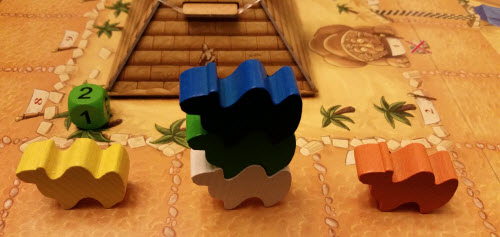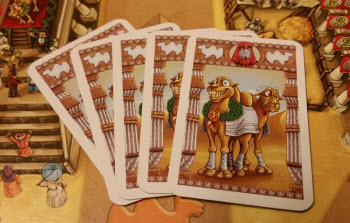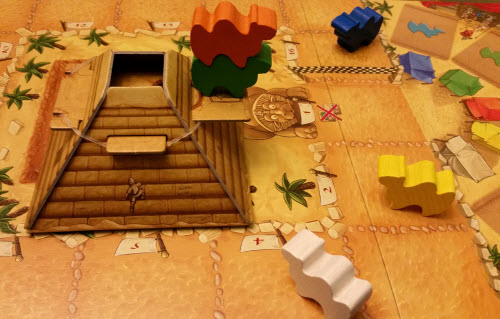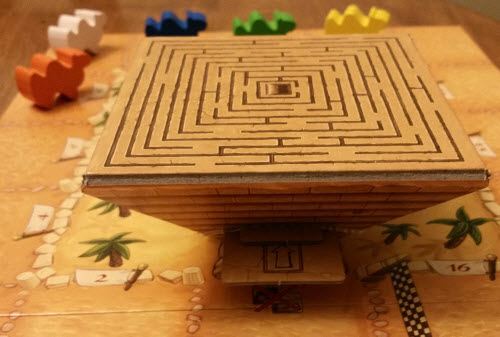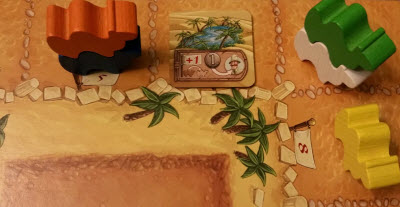…And with all racers in, it looks like we’re set for the Giza Classic. And away they go. It’s a great start, but Songbird has taken up the early lead, followed up on the inside by My Big Mouth, Don’t Look Back in Anger, and Going Nowhere. Champagne Supernova has dropped back early.
Around the first bend and Big Mouth makes break for it on the outside. She’s within spitting distance of Songbird. Meanwhile Champagne Supernova has charged up from behind, now racing third, with Going Nowhere in fourth, and Don’t Look Back forced into the rear.
Coming out of the turn and heading for the first open flat, Big Mouth and Supernova both burst forward, surging past Songbird. Don’t Look Back cuts the inside track and pushes Going Nowhere into the back of the pack. It’s anyone’s race here today! Coming up on the next turn we have…
The Premise
Giddy up for Camel Up! Be sure to pack the binoculars and a nice hat, as it’s time for an Egyptian camel race. And, as in most races, there’s money to be made. In Camel Up, a game of wacky racing behavior, players are affluent Egyptian aristocrats who have gotten together to bet on the outcome. Will their choices make them even wealthier still, or will they have backed the wrong camel?
The Rules
Camel Up is a casual racing game for 2-8 players that’s as quick to set up as it is to learn, centering around around five colored camels and a pyramid-shaped dice tumbler that controls them. Each camel comes with a corresponding die and three Betting tiles. At the beginning of the game, the camel’s starting positions are randomly determined; camels on the same space are stacked atop one another.
To begin, each player receives a stack of five betting cards (one for each camel), a double-sided Desert tile, and some money. In Camel Up, the youngest player starts.
The game takes place over a series of race segments, or legs. On a player’s turn, they take one of four actions:
- Move A Camel: First, collect a Pyramid tile. Eject one die from the pyramid, and then move the camel of its color forward that many spaces. Whenever camels move to a new space, they are stacked on top of any other camels present. Moreover, when a camel moves, it brings along any other camels currently stacked above it.
- Place / Move A Desert Tile: The player places (or moves) their Desert tile onto any empty space not adjacent to another Desert tile. Desert tiles possess an Oasis side or a Mirage side, and the player chooses which to use. A camel ending on an Oasis moves forward one additional space, whereas a camel ending on a Mirage moves backwards one space – and underneath any other camels. Anytime a camel lands on a player’s Desert tile, they collect 1 coin.
- Take A Betting Tile: Choose a camel and take its color’s topmost Betting tile. At the end of a race leg, if that camel is in first or second place Betting tiles provide money.
- Bet On The Winner Or Loser: The player chooses a camel card from their hand and places it face down on either the Overall Winner or Overall Loser section. At the end of the game, if the player bet correctly they collect money.
Once all five dice are used, the round ends. The camel furthest along the track (or the topmost camel if sharing the lead space) is the winner. For each Betting tile matching the lead camel, players collect the amount listed. For second place, they receive 1 coin instead. Otherwise they must pay 1. Players also collect 1 coin for each Pyramid tile they have.
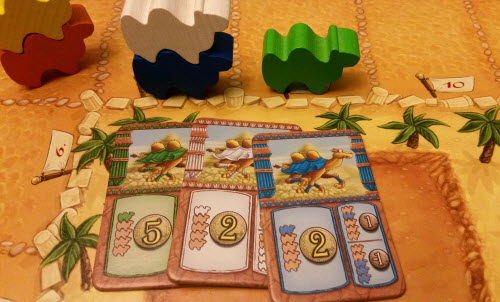
This player received five coin for Green being in first, one for White being in second, and loses one from Blue.
Then, all tiles are returned and a new round begins. The player to the left of the person who ended the previous round starts.
Players continue these rounds until a camel crosses the finish line. At that point, the game ends. A final leg scoring is done, followed by the final race bets.
For the Overall Winner and Overall Loser, each player whose card matches the first or last place camel, respectively, receives money, with the higher payouts going to those who bet earlier. For each card a player bet incorrectly, they must pay 1 instead.
Once tallied, the player with most money is the winner. They have proven themselves to be the most shrewd gambler amongst Egyptian high society and will walk away all the richer for it.
Everyone else can probably just throw away those betting slips and try to save face.
Never Tell Me The Odds
The first time you watch the camel you deemed in the best position to win quickly lose to one you didn’t see coming, you’ll understand how transient the outcomes of this game can be. Indeed, Camel Up has you trying to mitigate luck with one hand while asking you to embrace it with the other.
Camel Up makes no attempt to hide how luck-driven it is. Nor should it. Like most races, their inherent unpredictability is precisely what drives audience interest. No one knows who will win or what could happen. Will the returning champion repeat their performance, or will there be a stunning come from behind story? What if there is a storm, an accident, or a sudden volcano attack? All of those unknowns only increase our collective interest in a race beyond the participants themselves.
Camel Up takes advantage of that randomness through betting. Which is good, since we’d otherwise just be focusing on camels.
In this game, your bets are semi-educated guesswork on who you think will edge out a particular leg (or the overall game). If you think that you can fix the race, though, you’re in for a rude awakening.
| 5 Things You May Not Know About Camels |
|
The game is separated out into individual betting legs, providing far more substance than if the game were a straight dash to the finish line. On the one hand, this affords multiple rounds of striving for winnings, while this increasing the randomness of the game’s outcome.
On the other hand, this also diminishes the usefulness of the Winner / Loser bets, making them not far off from a blind guess until late in the game. This not only relegates them to an almost tacked on mechanic – especially since their payouts are only marginally better than the Bidding tiles – but it’s also another level of uncertainty.
There are only two ways to offset some of this luck. The first is the timing of your actions. For example, do you move a camel now, or do you take a Betting tile instead? Albeit small, when you take your actions do have an impact on the course of events, especially with lots of players. It’s precisely for that reason that although Camel Up can play with as few as two people, it hits its full stride with larger groups.
The other means to slightly reduce luck is through Desert tiles. These tiles are simple to use, and their use slightly increases the likelihood of shifting the race in your favor. They are also instrumental in preventing Camel Up from being solely a game of random outcomes, for without their use, the game would be almost devoid of the already light strategy it currently possesses.
However, even with these minor additions, luck is still the overwhelmingly predominant factor in who wins this game. Since the majority of the game’s outcome is determined regardless of player machinations, and with little controllable strategy to focus on, Strikers and Architects are best to skip these betting windows entirely. Similarly, although there are moments where a well-placed tile or specific action can pay off, Camel Up lacks the ability – or need – of heavy planning. It’s impossible to predict the outcome of a given leg in the game, let alone the race itself, and like most luck-centric quick games, the odds of Camel Up being favorable to Tacticians isn’t good.
Daredevils are far more of a sure bet. For those that thrive on being unpredictable themselves, Camel Up provides options. Whether it’s playing the long odds and betting on the camel in last place or picking one camel and doing what they can to hamper the others from advancing, they’ll appreciate being able to take chances for some nice payouts.
A Topsy-Turvy Approach
Yet nothing embodies the game’s genial nature more than its upside-down dice pyramid. This pyramid is Camel Up’s most novel attribute, used for determining camel movement, wherein you flip it over and push the slide to eject a die. Only after the device is moved is the die revealed.
This simple act builds up light pressure as the game wears on, and players often find themselves pausing in anticipation every time the die is cast. Not only is the persistence of this tension surprising, but it’s also entirely fitting in a betting game where the stakes go up as the race winds down.
Sure, it can seem a bit strange that the pyramid will spend a good portion of its time upside down, but this is also a world where camels stack themselves vertically. Plus, these goofy visual cues should help people in to avoid taking the game too seriously. For that purpose, it’s best to take Camel Up’s more whimsical aspects with a grain of sand.

“In fact, in Rand McNally, people wear hats on their feet and hamburgers eat people!”
That said, the pyramid comes with some minor pitfalls. For one, its inverted triangular shape makes it difficult for many to operate without using both hands, and although it’s constructed of moderately durable cardboard, long term wear should be a concern if abused or heavily played with. The Egyptian stone pyramids have stood up to harsh conditions for centuries. This one…probably not as long.
Moreover, while this tumbler lends well to the game’s theme (because how else are you to know it’s in Egypt), it also sometimes feels superfluous. That is, the pyramid effectively serves the same purpose as randomly drawing a die out of a bag and rolling it. While the pyramid combines rolling and revealing the die into a single action, it can also come across as an unnecessarily complex inclusion for a mere five dice.
No Excavations Required
Remove the pyramid, however, and what’s left is a stock racing game. Indeed, the flavor to Camel Up is incredibly surface level, which isn’t what Immersionists like to hear, but it also doesn’t need to be. Camel Up may not have a lot of mechanical or thematic depth to it, but it functions unequivocally just fine all the same.
In fact, the most appealing thing about Camel Up is how beautifully simplistic it is while still being engaging. Camel Up is short, sweet, and simple – although the rules insert makes it seem more complicated by repeating itself in multiple areas. What’s more, while the game may not be heavy on player interaction, each player’s turn does have an impact on one another. As a result, Socializers should easily find the trip down to the Camel Up racetrack a rewarding experience.
The Takeaway
When all the bets are in, Camel Up makes for an easy and entertaining game that’s three parts luck and one part timing. Its simple betting system and wacky premise combine into an experience that focuses less on victory and more about the race to the finish line itself. Camel Up is quick to grasp, the pyramid shaker is certainly original, and the stacking camels are equally cute and preposterous. Whether or not this all means it deserved the coveted 2014 Spiel des Jahres award is debatable though. Camel Up may not be challenging, but for those who enjoy a nice family or Filler Game, it certainly has all of the right traits. For those seeking a decent luck-centric casual game with straightforward rules and a charmingly simple presence, Camel Up is one wager worth making.
Also, this game is 100% camel spit free. Consider it a bonus.
Camel Up is a product of Z-Man Games.
Cardboard Republic Snapshot Scoring (Based on scale of 5):
Artwork: 3.5
Rules Clarity: 4
Replay Value: 3.5
Physical Quality: 4
Overall Score: 4
*The first eyelashes part is scientifically true. The second part is fashionably true, at least according to the latest edition of Camel Cosmopolitan.
Photo Credits: Simpsons clip by 20th Century Fox.

